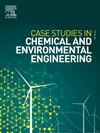离子原子比对反电渗析过程中碳纳米管颗粒扩散和渗透性的影响
Q1 Environmental Science
Case Studies in Chemical and Environmental Engineering
Pub Date : 2024-12-25
DOI:10.1016/j.cscee.2024.101084
引用次数: 0
摘要
本研究采用分子动力学模拟的方法研究了电流作用下碳纳米管中的水输运,重点研究了不同离子原子比对关键系统参数的影响。这些参数包括随着离子浓度变化的电流强度、流体电流强度、最大密度、氢键计数和相互作用能。该研究旨在研究这些变化对离子迁移率、水渗透性和离子-碳纳米管相互作用的影响。该研究分两个阶段进行:平衡,其次是原子转换的分析和样品中各种原子比的创建。在第一阶段,原子样品的动能收敛到0.162 eV, 10 ns后势能达到2.048 eV,表明结构迁移率和原子间的吸引力有限。平衡后,我们实现了原子转变过程,创造了不同的原子比。结果表明,随着流体中离子比的增加,电流强度从5.31 e/ns增加到5.52 e/ns。更高的离子浓度导致更高的载流子密度,增强离子迁移率和离子通过碳纳米管的传输。较高的离子浓度不仅使最大密度从4.83个原子/nm³降低到4.65个原子/nm³,而且还增加了断裂氢键的数量,这可能会影响水的输送和流动动力学。最后,根据研究结果,有133个断裂的氢键,而不是116个,并且当原子的离子百分比上升到5%时,纳米流体的流动强度和电流都增加了。本文章由计算机程序翻译,如有差异,请以英文原文为准。
Effect of atomic ratio of ions on the particle diffusion and permeability of carbon nanotubes in reverse electrodialysis process using molecular dynamics simulation
This study employed molecular dynamics simulations to investigate water transport through a carbon nanotube under an electric current, focusing on how varying ion atomic ratios influence key system parameters. These parameters include electric current intensity, fluid current intensity, maximum density, hydrogen bond count, and interaction energy as ion concentration changed. The research aimed to examine the effects of these changes on ion mobility, water permeability, and ion–carbon nanotube interactions. The study is conducted in two phases: equilibration, followed by the analysis of atomic transformations and the creation of various atomic ratios in samples. In the first phase, the kinetic energy of the atomic sample converges to 0.162 eV, and the potential energy reaches to 2.048 eV after 10 ns, indicating limited structural mobility and attractive forces among atoms. After equilibration, we achieved the atomic transformation process and created different atomic ratios. The results indicate that increasing ion ratios in the fluid led to a rise in electric current intensity, from 5.31 to 5.52 e/ns. Higher ion concentrations resulted in a greater density of charge carriers, enhancing ionic mobility and ion transport through the carbon nanotube. Moreover, higher ionic concentrations not only reduced the maximum density from 4.83 to 4.65 atoms/nm³ but also increases the number of broken hydrogen bonds, which could impact water transport and flow dynamics. Finally, according to the findings, there are 133 broken hydrogen bonds instead of 116, and the strength of the nanofluid flow, as well as the electric current, both increased when the ionic percentage of atoms rose to 5 %.
求助全文
通过发布文献求助,成功后即可免费获取论文全文。
去求助
来源期刊

Case Studies in Chemical and Environmental Engineering
Engineering-Engineering (miscellaneous)
CiteScore
9.20
自引率
0.00%
发文量
103
审稿时长
40 days
 求助内容:
求助内容: 应助结果提醒方式:
应助结果提醒方式:


